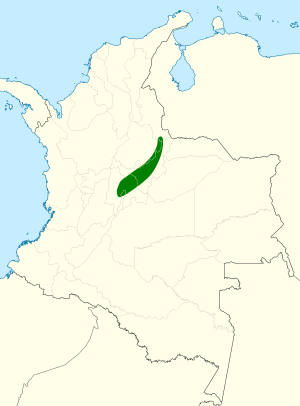Golden-bellied starfrontlet facts for kids
Quick facts for kids Golden-bellied starfrontlet |
|
|---|---|
 |
|
| Illustration by John Gould | |
| Conservation status | |
| Scientific classification | |
| Genus: |
Coeligena
|
| Species: |
bonapartei
|
 |
|
| Synonyms | |
|
|
The golden-bellied starfrontlet (Coeligena bonapartei) is a beautiful type of hummingbird. It belongs to a group of hummingbirds called "brilliants." This bird lives only in Colombia, a country in South America.
Contents
About the Golden-bellied Starfrontlet
What's in a Name?
The golden-bellied starfrontlet was once placed in a different group of birds. But since the mid-1900s, it has been part of the Coeligena genus.
Scientists around the world mostly agree that the golden-bellied starfrontlet is its own unique species. However, some groups are still discussing if a few similar birds, like the Perija starfrontlet and golden-tailed starfrontlet, should be considered separate species or just types of the golden-bellied starfrontlet.
The bird's scientific name, bonapartei, honors a famous person named Charles Lucien Bonaparte. He was a French naturalist and a cousin of Napoleon Bonaparte.
How to Spot a Golden-bellied Starfrontlet
This hummingbird is about 10.9 centimeters (4.3 inches) long. Its long bill is about 3.0 centimeters (1.2 inches). Males are a bit heavier, weighing about 6.6 grams (0.23 ounces), while females weigh around 6.4 grams (0.23 ounces).
Both male and female birds have a small white spot behind their eyes.
- Male Birds: They have a dark crown on their head with a shiny green forehead. Their upper back is a bright dark green. This color changes to a greenish copper and then a golden orange near their tail. Their throat and chest are sparkling green, and they have a small violet patch on their throat. The rest of their belly can be shiny copper or reddish gold. Their slightly forked tail is a golden bronzy green.
- Female Birds: Their forehead is plain green. The rest of their upper parts are similar to the male's but not as bright. Their throat is a plain buff color with green spots on the sides. Their chest is a mix of buff and green. The rest of their belly is mostly cinnamon, with a reddish gold lower belly and a coppery gold area near their tail. Their tail feathers are bronze and sometimes have buff tips.
Where They Live and Their Home
Golden-bellied Starfrontlet Habitat
The golden-bellied starfrontlet lives in the Eastern Andes mountains of Colombia. You can find them between the Boyacá Department and the Metropolitan Area of Bogotá.
These birds mainly live inside and along the edges of wet montane forests. They also live in dwarf forests and more open areas with scattered plants. They can be found at high elevations, from 1,400 to 3,200 meters (4,600 to 10,500 feet) above sea level.
Golden-bellied Starfrontlet Behavior
Movement and Migration
The golden-bellied starfrontlet does not migrate. It stays in the same area all year long.
What They Eat
This hummingbird drinks nectar from tube-shaped flowers. They usually feed at low to medium heights. They often use a method called "trap-lining." This means they visit a regular circuit of flowering plants. Besides nectar, they also catch small arthropods (like insects or spiders). They do this by picking them off leaves, hovering in the air, or catching them while flying.
Reproduction and Life Cycle
Scientists don't know all the details about when golden-bellied starfrontlets breed. It seems their breeding season might be from January to July. We don't have descriptions of their nests, eggs, or how long it takes for the eggs to hatch or for the young birds to leave the nest.
Their Calls and Songs
There are not many recordings of the golden-bellied starfrontlet's sounds. We know their calls include a short, quick twitter. They also make a more complex chattering sound that goes up and down in pitch.
Conservation Status
Is the Golden-bellied Starfrontlet Safe?
The IUCN (International Union for Conservation of Nature) has listed the golden-bellied starfrontlet as a species of "Least Concern." This means they are not currently in immediate danger of disappearing.
However, their home range is small. Scientists also don't know exactly how many of these birds exist, but they believe the population might be shrinking. There are no immediate threats that have been clearly identified. But, the areas where they live are seeing more human activities. These include building new towns and looking for minerals. Also, these birds do not live in any protected areas.
See also
 In Spanish: Coeligena bonapartei para niños
In Spanish: Coeligena bonapartei para niños


